Comparative Appetites: Greed vs. Need in Tomás Gutiérrez Alea's The Last Supper
Ellen K. Brightwell, University of South Carolina
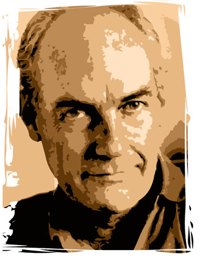 In 1964 Manuel Moreno Fraginals wrote El Ingenio (The Sugar Mill) a postrevolutionary take on the history of the Cuban sugar industry. A footnote in the book recounts the real-life incident of the Count of Bayona, an eighteenth century Cuban slave owner who recreated Christ’s last supper with twelve of his slaves. The experiment goes awry, the slaves rebel, and the Count, enraged at having “humbled” himself before them, orders their execution. Though Fraginals may not have devoted much attention to the incident, it served as the inspiration for Tomás Gutiérrez Alea’s 1976 film La última cena (The Last Supper), and, according to Paul Schroeder, both representations can be read as Marxist reinterpretations of Cuban history, with emphasis on the previously unacknowledged working masses (78). Hence, if one considers Schroeder's assertion that Alea's films "are windows through which one can glimpse the Cuban Revolution from within"(134), it is necessary to examine why the camera's gaze seems to be more in accordance with the slave's position, thereby privileging the Afro-Cuban segment of the island's history and demanding attention to certain slavery-specific elements beyond the superficial focus on inconsistencies in Christian doctrine. Karen Jaehne, quoting Pastor Vega, another Cuban director, has noted that "'The Last Supper is one in a series of films attempting to reevaluate the role of the blacks in Cuba's national development'"(48), but her critical focus is on the religious metaphor which, she says, represents "the plight of the Christian faith staggering under the sophistication and inefficacy of eighteenth-century materialism and 'enlightenment'"(51). While the discrepancies between belief and practice are certainly evident in the film, I believe that The Last Supperis a political allegory more concerned with hunger than religious metaphor, and it is this particular and prominent want that better reflects the Marxist focus of the film. I contend that Alea's astonishingly long 55 minute dinner scene offers a symbolic interpretation that foregrounds food and its relationship with both Cuban history and black economy. This study takes into account the comparative appetites of slaves and slave owners, and demonstrates the way that the literal use of food and its commodification stands in the way of commensality, and how that, in turn, is related to Cuba's revolutionary project. It is not so much that the slaves cannot understand the religious symbols offered to them, it is that they are too hungry to consume the Christian / capitalist ideology.
In 1964 Manuel Moreno Fraginals wrote El Ingenio (The Sugar Mill) a postrevolutionary take on the history of the Cuban sugar industry. A footnote in the book recounts the real-life incident of the Count of Bayona, an eighteenth century Cuban slave owner who recreated Christ’s last supper with twelve of his slaves. The experiment goes awry, the slaves rebel, and the Count, enraged at having “humbled” himself before them, orders their execution. Though Fraginals may not have devoted much attention to the incident, it served as the inspiration for Tomás Gutiérrez Alea’s 1976 film La última cena (The Last Supper), and, according to Paul Schroeder, both representations can be read as Marxist reinterpretations of Cuban history, with emphasis on the previously unacknowledged working masses (78). Hence, if one considers Schroeder's assertion that Alea's films "are windows through which one can glimpse the Cuban Revolution from within"(134), it is necessary to examine why the camera's gaze seems to be more in accordance with the slave's position, thereby privileging the Afro-Cuban segment of the island's history and demanding attention to certain slavery-specific elements beyond the superficial focus on inconsistencies in Christian doctrine. Karen Jaehne, quoting Pastor Vega, another Cuban director, has noted that "'The Last Supper is one in a series of films attempting to reevaluate the role of the blacks in Cuba's national development'"(48), but her critical focus is on the religious metaphor which, she says, represents "the plight of the Christian faith staggering under the sophistication and inefficacy of eighteenth-century materialism and 'enlightenment'"(51). While the discrepancies between belief and practice are certainly evident in the film, I believe that The Last Supperis a political allegory more concerned with hunger than religious metaphor, and it is this particular and prominent want that better reflects the Marxist focus of the film. I contend that Alea's astonishingly long 55 minute dinner scene offers a symbolic interpretation that foregrounds food and its relationship with both Cuban history and black economy. This study takes into account the comparative appetites of slaves and slave owners, and demonstrates the way that the literal use of food and its commodification stands in the way of commensality, and how that, in turn, is related to Cuba's revolutionary project. It is not so much that the slaves cannot understand the religious symbols offered to them, it is that they are too hungry to consume the Christian / capitalist ideology.
I cannot claim to situate a Cuban film within a Marxist allegorical interpretation without examining two critical works dealing with so called “third world” narratives and the use of allegory to represent nationalist imaginings. The first of these, to be dealt with here, is “Third World Literature in the Era of Multinational Capitalism” by Marxist critic Frederic Jameson, in which he posits that all subaltern texts, of which The Last Supper, being a Cuban film, is therefore representative, “are necessarily . . . allegorical, and in a very specific way: they are to be read as national allegories, even when, or perhaps I should say, particularly when their forms develop out of the predominantly western machineries of representation, such as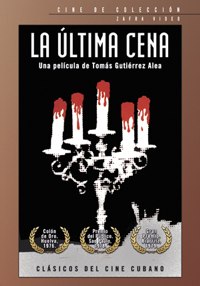 the novel” (69, original emphasis). For Jameson, the world is divided into three seemingly distinct categories classified according to their relation to capitalism and cultural imperialism. He argues the impossibility of cultural and economic autonomy for the third world, as he labels it, due to the fact that “they are all in various distinct ways locked in a life-and-death struggle with first world cultural imperialism — a cultural struggle that is itself a reflection of the economic situation of such areas in their penetration by various stages of capital, or as it is sometimes euphemistically termed, of modernization” (68). One of the two modes of production most insistently resistant to capitalism, he claims, is “primitive, tribal societies” (62), such as those in Africa, thus making Alea’s film a putatively perfect text for analysis through a Jamesion lens, with it’s revolutionary look at the imported African presence in colonial Cuba, a country that receives special mention in his essay as a unique locus of social consciousness (81).(1)
the novel” (69, original emphasis). For Jameson, the world is divided into three seemingly distinct categories classified according to their relation to capitalism and cultural imperialism. He argues the impossibility of cultural and economic autonomy for the third world, as he labels it, due to the fact that “they are all in various distinct ways locked in a life-and-death struggle with first world cultural imperialism — a cultural struggle that is itself a reflection of the economic situation of such areas in their penetration by various stages of capital, or as it is sometimes euphemistically termed, of modernization” (68). One of the two modes of production most insistently resistant to capitalism, he claims, is “primitive, tribal societies” (62), such as those in Africa, thus making Alea’s film a putatively perfect text for analysis through a Jamesion lens, with it’s revolutionary look at the imported African presence in colonial Cuba, a country that receives special mention in his essay as a unique locus of social consciousness (81).(1)
However, as Aijaz Ahmad has cogently argued in his essay, “Jameson’s Rhetoric of Otherness and ‘National Allegory,’” it is nearly impossible to classify a homogenous category of third world literature, much less a third world itself, and that Jameson’s theory reifies a “sustained, powerful myth of a primal innocence, when it comes to the colonial encounter”(21). Ahmad does not separate the world into three capitalist, socialist, and emerging sectors; rather, he posits one world, with various manifestations of nearly ubiquitous economic, social, racial, class, and gender struggles. For him, the world is not divided economically, but unified through a “ferocious struggle of capital and labor” (10). Hence, I situate myself in this debate by proposing that what complicates this reading of Alea’s film, and removes it from classification as a third world (Jameson’s term, not mine) nationalist allegory of colonial encounter, is that it spans nearly two centuries, and cannot therefore be encapsulated as a study of the search for social consciousness in the midst of revolutionary struggle. It can, however, be viewed as very real critique of the struggle between capital and labor. Furthermore, while not to be “read” merely as an isolated and reductive national allegory, the film does make use of certain references that are situated within a narrative that is, in many respects, uniquely related to Cuba and its revolutionary agenda. The first of these is a reaffirmation of Cuba’s African heritage, a priority in the formation of a post-Revolutionary national identity, the second is an emphasis on the apportionment of goods, and in particular, food. Thus the analysis of the film begins in the intersections and interstices between blackness and hunger.
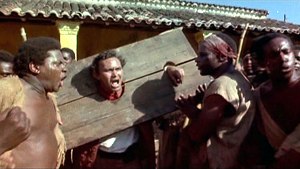 Issues of black hunger are clearly not limited to Alea's film. The nexus of slavery and food is prominent in Afro-Cuban and African American literature, and many critics have taken note of the relationship between blacks and food's production, consumption, and commodification. Andrew Warnes has studied the link between food and resistance in twentieth -century African American literature and concludes that, "hunger was as normalized and integral for the status of slaves as illiteracy. If to be a slave was to be unlettered, then it was equally true that it was to be hungry"(3). George Andrew Reid, writing about black slavery in Latin America, notes that, “Food emerges as a central theme in one of the very few first-person accounts left by a Latin American slave, the autobiography of Afro-Cuban Juan Francisco Manzano”(27). Manzano is often frustratingly vague about dates, places, and names, but he vividly recalls the role that hunger and food, both bestowed and withheld, played in his life. He writes, “Always hungry, it is not surprising that I ate everything I found, . . . I would stuff myself and gobble the food down almost without chewing, so I frequently had indigestion”(59). Since his relatively privileged childhood where, “I was given my food from the same table and ate at the feet of my mistress the Marchioness de Prado Ameno”(55), Manzano defines sharing food as the “most sacred and essential kindness”(101), and he recounts numerous moments when others risked the owner’s or overseer’s ire by providing him with food during periods of punishment and deprivation. In Manzano’s account, his mistress’s physical and emotional cruelty is always intertwined with his own hunger and the withholding of food, and given his many erasures of past and denials of ethnic and cultural identity, it is not improvident to suggest that physical hunger in the slave’s narrative may also be a trope for a lack of self–expression and realization. As a child he shares food with his white mistress, later with a white overseer, but the only food exchanged between himself and other blacks is in secret, what “his brother or some other boy slipped under the door”(77), thereby iterating the importance of shared rituals in solidifying cultural and personal identity.
Issues of black hunger are clearly not limited to Alea's film. The nexus of slavery and food is prominent in Afro-Cuban and African American literature, and many critics have taken note of the relationship between blacks and food's production, consumption, and commodification. Andrew Warnes has studied the link between food and resistance in twentieth -century African American literature and concludes that, "hunger was as normalized and integral for the status of slaves as illiteracy. If to be a slave was to be unlettered, then it was equally true that it was to be hungry"(3). George Andrew Reid, writing about black slavery in Latin America, notes that, “Food emerges as a central theme in one of the very few first-person accounts left by a Latin American slave, the autobiography of Afro-Cuban Juan Francisco Manzano”(27). Manzano is often frustratingly vague about dates, places, and names, but he vividly recalls the role that hunger and food, both bestowed and withheld, played in his life. He writes, “Always hungry, it is not surprising that I ate everything I found, . . . I would stuff myself and gobble the food down almost without chewing, so I frequently had indigestion”(59). Since his relatively privileged childhood where, “I was given my food from the same table and ate at the feet of my mistress the Marchioness de Prado Ameno”(55), Manzano defines sharing food as the “most sacred and essential kindness”(101), and he recounts numerous moments when others risked the owner’s or overseer’s ire by providing him with food during periods of punishment and deprivation. In Manzano’s account, his mistress’s physical and emotional cruelty is always intertwined with his own hunger and the withholding of food, and given his many erasures of past and denials of ethnic and cultural identity, it is not improvident to suggest that physical hunger in the slave’s narrative may also be a trope for a lack of self–expression and realization. As a child he shares food with his white mistress, later with a white overseer, but the only food exchanged between himself and other blacks is in secret, what “his brother or some other boy slipped under the door”(77), thereby iterating the importance of shared rituals in solidifying cultural and personal identity.
Sidney Mintz has written much about the history of food, particularly sugar, and he also finds psychosociological significance in the emergence of the slave-created Caribbean cuisine. Most of the slaves had their own garden plots, which, for many, represented their main source of sustenance. In creating food based on the materials at hand, the slaves were exercising control and creativity over at least one facet of their lives, and for Mintz, this cultivation, preparation, and consumption of food is tantamount to an expression of freedom and humanity (36). He says, "For many people, eating particular foods serves not only as a fulfilling experience, but also as a liberating one, an added way of making some kind of a declaration"(13). Moreover, the production of produce resulted in a slave economy that was not reliant on the master's household. Jane Ferry writes, "Within the confines of the house garden and land provision, the slave community organized their efforts to build an economic system in which they could earn and spend money. Working in collective solidarity, bonded slaves planted and tended cash crops, raised livestock, manufactured finished goods, marketed their own products, and used the proceeds for self-improvement" (47). This would seem to be at odds with Jameson’s claim that the “primordial crime of capitalism [is the] primal displacement of the older forms of collective life,” (84), for here the cultivation of food represents a disruption and adaptation of the economic system that reinforces collectivity. This phenomenon is also present in Miguel Barnet's The Autobiography of a Runaway Slave, another Cuban text with revolutionary leanings. Barnet, using the words of his subject Esteban Montejo, provides a detailed description of the conucos, the small plots of land where the slaves grew the produce and raised livestock that proved essential to their survival and economy. According to Montejo, “[T]hose products were sold to the guajiros who came straight from town [. . .]. But they never sold their‘taters. I learned from the old timers to eat 'taters, which are very nutritious” (25-26).
In Montejo’s description of the garden plots food serves as the locus of collective knowledge, and, to a certain extent, rebellion, since the slaves could refuse to sell items, as well. In a larger sense, the cultivation and distribution of food represents access to power and subversion of the system, and indeed, it became fashionable during the 1960's to refer to the slaves' garden plots and the activities surrounding them as "a breach in the mode of production"(Mintz 41). Andrews also comments on the significance of the garden plots, noting that “[P]roduce grown by slaves for their own use was a frequent bone of contention between masters and slaves, and a prime example of the ambiguities of their relationship” (26). Though the slaves obviously benefitted from the conucos, the increased food production also reduced owners’ costs and provided what many perceived to be “pacifying” effects on the slaves, who, mollified though they might have been, were quite proprietary about the plots and demanded sufficient time off to work them (Andrews 26).Moreover, in growing their own produce the blacks were able to exercise some authority in their gustatory rituals, which, for many, represented solidarity through commensality. Montejo says, "Some workers were in the habit of going to the overseer's office for authorization to get the uncooked food and take it to the barracoon. They cooked on their own fires. A man who had a steady woman ate with her. That's what I did, too, because when I had a steady woman, I wasn't going to suffer through the heat and suffocation of the eating house"(63).
Thus, for many slaves cooking and eating together offered refuge and freedom of expression, and many of the dishes they created became part of the mainstream diet. It is also important to remember that the slaves were not just cooking for themselves; they prepared virtually all the food eaten on the plantations. This is significant because it represents a form of transculturation, of which the whites, at least, would not have necessarily have been aware. If the production of food and the creation of meals represent a declaration of humanity and an expression of freedom, the act of consumption represents a tacit confirmation of other. Furthermore, serving the master slave-created dishes that have their roots in African culinary history therefore becomes an act of cultural and personal imposition. Hence, in inviting his slaves to sit at table and partake of the feast that had almost certainly been prepared by one of their own, the Count of The Last Supper is inadvertently encouraging a ritual of commensality that trumps his religious metaphor.
In turning to the film sequence I would like to again cite Jane Ferry, whose illuminating book, Food in Film, gives insight into the importance of food scenes in the movies. She writes:
Although depicted as a seemingly natural function, food scenes in film not only signify social class, identity, and nationality, but also provide insight into the complex ways in which food and eating are entangled with other aspects of social / cultural development. A close observation of food scenes within the narrative framework of film reveals its powerful, coded, cultural meanings that structure the arrangements of social life. . . . Eating scenes articulate conflict or cooperation, inform an individual's or group's place in society, and express personal identity (1).
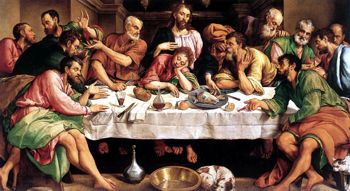 If we take this to be true, the Count's actions should reflect a communion, or conversation, as it were, that goes beyond the religious meaning. Towards the end of the film he tells the priest that he used the dinner to teach the slaves "an important lesson in humility," to which the priest replies, "Perhaps what they learned was to sit at the master's table." Indeed, this is the crux of the matter, and the predominant miscommunication of a scene rife with them. As Juan Antonio Hernández notes, "La secuencia de la cena muestra la imposibilidad de imponer una interpretación única a los símbolos centrales del catolicismo.[ . . .] De hecho, toda la escena—con la sola excepción del relato del cimarrón—podría leerse como una negación por el significado, entre amo y esclavos, de tales símbolos"(843). The conflation of symbols and the shifting religious roles reflect the futility of the religious metaphor. The Christ figure is alternately Don Manuel, the Count, Sebastian, and Don Manuel again. Judas, too, has his share of avatars. It is impossible to get a fixed sense on the message because the analogy is manipulated to fit the moment, and because at the heart of the experiment lies a conflict of appetites: the pursuit of material gain on the part of the Count, and the actual physical hunger of the slaves, who, in being invited to dinner, assume the measure of equality inherent in the gesture. Hunger, whether it be for riches, freedom, or actual food, informs the entire scene.
If we take this to be true, the Count's actions should reflect a communion, or conversation, as it were, that goes beyond the religious meaning. Towards the end of the film he tells the priest that he used the dinner to teach the slaves "an important lesson in humility," to which the priest replies, "Perhaps what they learned was to sit at the master's table." Indeed, this is the crux of the matter, and the predominant miscommunication of a scene rife with them. As Juan Antonio Hernández notes, "La secuencia de la cena muestra la imposibilidad de imponer una interpretación única a los símbolos centrales del catolicismo.[ . . .] De hecho, toda la escena—con la sola excepción del relato del cimarrón—podría leerse como una negación por el significado, entre amo y esclavos, de tales símbolos"(843). The conflation of symbols and the shifting religious roles reflect the futility of the religious metaphor. The Christ figure is alternately Don Manuel, the Count, Sebastian, and Don Manuel again. Judas, too, has his share of avatars. It is impossible to get a fixed sense on the message because the analogy is manipulated to fit the moment, and because at the heart of the experiment lies a conflict of appetites: the pursuit of material gain on the part of the Count, and the actual physical hunger of the slaves, who, in being invited to dinner, assume the measure of equality inherent in the gesture. Hunger, whether it be for riches, freedom, or actual food, informs the entire scene.
There is a telling moment early in the film which serves as a microcosm of the supper. Prior to gathering the slaves the Count feeds his caged bird, saying, "Now that I've fed you, you must sing for your master," which, in essence, is what he expects from his caged slaves. But his intentions are inadvertently (?) undone by the priest who sets the tone for the dinner with another reference to food preparation and consumption: "To be in Heaven," he says, "is to be in the dining room, not the kitchen. To be at the same table as the Lord, that is what it means to be in Heaven." No wonder, then, that the slaves'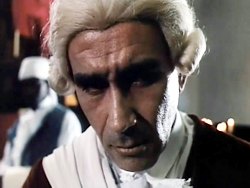 understanding of the event to come is one that is conceived within a paradigm of food, and no wonder that this particular line presages the dinner scene. It is a significant moment in the film's political awareness, both affirming the communist goal of equal apportionment and undoing the religious message by reducing it to the level of metaphor.
understanding of the event to come is one that is conceived within a paradigm of food, and no wonder that this particular line presages the dinner scene. It is a significant moment in the film's political awareness, both affirming the communist goal of equal apportionment and undoing the religious message by reducing it to the level of metaphor.
The actual meal itself, meant as an indoctrination into the arcane rites of Catholicism, is a series of misinterpretations and miscommunications between master and slaves, and indeed, it is hardly surprising. Even what can be called the meal's structural elements are observed unevenly, if at all. As Roland Barthes notes, "Food is a system of communication, a body of images, a protocol of usages, situations and behavior"(21). Mary Douglas also provides definition for the category of a meal: "Meals properly require the use of at least one mouth-entering utensil per head, whereas drinks are limited to mouth-touching ones. Meals require a table, a seating order, restriction on movement and on alternative occupations"(41). During the last supper, almost all of these conventions are violated. The Count changes the seating order according to his mood and the status of his metaphor. Various characters get up and wander the dining room at will, mostly for performative purposes. Furthermore, the majority of the slaves bring the meat directly to mouth, eschewing the inconvenience of fork and knife, and some forgo the glass for the decanter. Certainly, this dinner is rife with alternative occupations: the slaves playfully throw food at one another, some sleep, and some, like the Count, and like Sebastian, don't even eat very much. After his initial few bites the Count turns to wine, and Sebastian's involvement with the food is limited to using it as a prop, a pig’s head he places in front of his own, thereby equating himself with food, and underscoring the slave industry’s treatment of humans as animals and chattel.
The Count's refusal to take part in his own ceremony is also telling: his actions belie his words and reflect Ferry's understanding of innate cultural coding. His "humility" is revealed as performance, and the tensions between word and deed are evident in his reaction to Ambrosio's kiss: he wipes the skin where his lips had touched. This moment reinforces the film’s Marxist focus by replicating Hegel’s Master/Slave dialectic, perhaps the best known passage from the Phenomenology of Spirit and certainly the most concretely useful to Marx. Hegel’s formulation of the dialectic probably does not need retelling, but in simplistic terms the Master, or the Lord, and the Slave (bondsman) represent two factions competing for 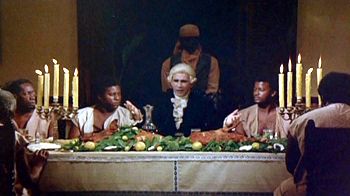 recognition, and the one who prioritizes honor “wins” the battle, thereby becoming the master of the slave, who sacrifices honor to preserve body. Yet the Master needs the Slave, for he is the only one who can recognize him as superior. However, by giving in to the Master, the Slave has lost his humanity, and is therefore not fully capable of cognition. The problem for the Lord, Hegel writes, is that, “What now really confronts him is not an independent consciousness, but a dependent one. He is, therefore, not certain of being-for-self as the truth of himself” (117, original emphasis). The Slave, on the other hand, by truly knowing work and creative production, achieves total self-consciousness, for work is “desire held in check, fleetingness staved off; . . .it is in this way, therefore, that consciousness, qua worker, comes to see in the independent being . . . its own independence”(Hegel 118). It is worth noting that Jameson also uses the dialectic to formulate the relationship between first and third world countries, placing the latter as perpetual slave despite all efforts at reversal (85), though any such reference to Hegel when discussing the perceived “third world” are fraught with dangerous implications about historical production. Nonetheless, the dialectical moment in Alea’s film is fascinating for it’s inclusion in the midst of a religious reenactment, communion, which takes place at a dinner table. Though the Count assumes Christ’s role in the Christian communion ritual, symbolically giving of himself to the slaves so that they may eat and drink and know him, he refuses to acknowledge them as equals, despite Christianity’s affirmation that breaking consecrated bread together is among the holiest rituals, and the origin of “companion,” from the Latin, “to share bread with” (Korsmeyer 200). But the Count cannot complete the dialectic; by taking center stage at the table, his position from which to proselytize, he commands the recognition from the slaves without ever acknowledging their own humanity, an act which ultimately undoes his forced indoctrination because the slaves, or at least Sebastian, recognize the hollowness of his gesture. Sebastian's refusal is total: the only thing to pass his lips is a forced measure of rum which is then expectorated into his master's face, evidence of his absolute rejection of forced beliefs.
recognition, and the one who prioritizes honor “wins” the battle, thereby becoming the master of the slave, who sacrifices honor to preserve body. Yet the Master needs the Slave, for he is the only one who can recognize him as superior. However, by giving in to the Master, the Slave has lost his humanity, and is therefore not fully capable of cognition. The problem for the Lord, Hegel writes, is that, “What now really confronts him is not an independent consciousness, but a dependent one. He is, therefore, not certain of being-for-self as the truth of himself” (117, original emphasis). The Slave, on the other hand, by truly knowing work and creative production, achieves total self-consciousness, for work is “desire held in check, fleetingness staved off; . . .it is in this way, therefore, that consciousness, qua worker, comes to see in the independent being . . . its own independence”(Hegel 118). It is worth noting that Jameson also uses the dialectic to formulate the relationship between first and third world countries, placing the latter as perpetual slave despite all efforts at reversal (85), though any such reference to Hegel when discussing the perceived “third world” are fraught with dangerous implications about historical production. Nonetheless, the dialectical moment in Alea’s film is fascinating for it’s inclusion in the midst of a religious reenactment, communion, which takes place at a dinner table. Though the Count assumes Christ’s role in the Christian communion ritual, symbolically giving of himself to the slaves so that they may eat and drink and know him, he refuses to acknowledge them as equals, despite Christianity’s affirmation that breaking consecrated bread together is among the holiest rituals, and the origin of “companion,” from the Latin, “to share bread with” (Korsmeyer 200). But the Count cannot complete the dialectic; by taking center stage at the table, his position from which to proselytize, he commands the recognition from the slaves without ever acknowledging their own humanity, an act which ultimately undoes his forced indoctrination because the slaves, or at least Sebastian, recognize the hollowness of his gesture. Sebastian's refusal is total: the only thing to pass his lips is a forced measure of rum which is then expectorated into his master's face, evidence of his absolute rejection of forced beliefs.
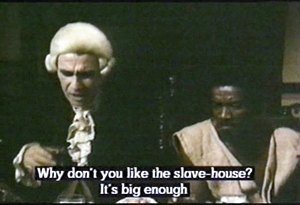 But for all that, communication does occur at table, though the means to do not achieve the desired end. The master's principal aim is to distill ideology in its most literal Marxist application; his story of St. Francis' suffering is meant to encourage humility and the slaves' acceptance of their lot in life. In addition, he uses the story of original sin, perhaps the most famous (or infamous) food parable in the history of mankind to justify their labor. After Eve got them all kicked out of paradise, he says, "The holiday was over. If you want to eat, you must work and sweat blood." But you cannot eat dogma, to paraphrase Margaret Mead (17), and for the slaves, whose sole source of autonomy is linked with food, meals are rituals, feasts are celebrations, and even the most rudimentary elements of quotidian life are endowed with references to this fact. One of the slaves remarks that, "For the black, one day's a feast, the next day's a wake," and another, "You don't see the cookpot till it burns your arse." What the slaves learn goes beyond the Count’s intentions of prescribed mimesis. Instead, the dinner serves to solidify an understanding of equality that finds voice in the sharing of victuals, and which ideally could be extrapolated to shared religious practice.
But for all that, communication does occur at table, though the means to do not achieve the desired end. The master's principal aim is to distill ideology in its most literal Marxist application; his story of St. Francis' suffering is meant to encourage humility and the slaves' acceptance of their lot in life. In addition, he uses the story of original sin, perhaps the most famous (or infamous) food parable in the history of mankind to justify their labor. After Eve got them all kicked out of paradise, he says, "The holiday was over. If you want to eat, you must work and sweat blood." But you cannot eat dogma, to paraphrase Margaret Mead (17), and for the slaves, whose sole source of autonomy is linked with food, meals are rituals, feasts are celebrations, and even the most rudimentary elements of quotidian life are endowed with references to this fact. One of the slaves remarks that, "For the black, one day's a feast, the next day's a wake," and another, "You don't see the cookpot till it burns your arse." What the slaves learn goes beyond the Count’s intentions of prescribed mimesis. Instead, the dinner serves to solidify an understanding of equality that finds voice in the sharing of victuals, and which ideally could be extrapolated to shared religious practice.
That the slaves used the preparation and consumption of food to articulate identity is documented, but the customs became so ingrained they still carry import. Ferry notes that in America, "During the post-bellum period free slaves continued the communal ritual of sharing food together and reaffirming their humanity. [. . .] African-Americans used food, once again, to articulate freedom"(49). Furthermore, these rites find voice in black literature: Zora Neale Hurston often celebrates cooking, Ralph Ellison's Invisible Man is dialectically connected with his heretofore rejected ancestry via a warm yam, and the Cuban poet Nancy Morejón exalts the domestic life spent at the dinner table in her poem "The Supper," which Yvonne Captain-Hidalgo identifies as "the beauty of a common moment"(597). Hence, for the slaves at Alea's dinner scene, the meal is not an object lesson but an act of sharing, in many ways the reenactment of daily life--albeit with better props--and not an isolated Christian event. To return once more to Ferry's work on the symbolic significance of food and meals, I quote:
Food is not only an isolated object of biological necessity, but it is an object of communication. Food has been a symbolic repository of shared values and a solemn bonding ritual that reaches back 2 million years. The act of eating together expresses the quality of social relationships, and the day to day pattern of social interactions and alliances. (59)
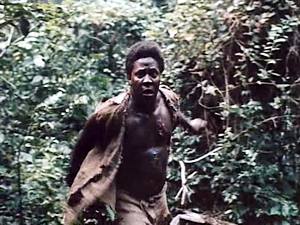 The blacks, who grew the food, prepared the food, served the food, and consumed the food, represent a complete hermeneutic circle, and the resulting epistemological clashes, such as literally interpreting the Eucharist as cannibalism, are not only inevitable, but politically trenchant. I believe Alea’s inclusion of cannibalism is an intentional reference to the national project in that it recalls Fernando Retamar’s 1971 essay on Caliban, Shakespeare’s imagined version of the Latin American other. In a 1989 article for Cine Cubano entitled “El verdadero rostro de Calibán,” Alea associates the maligned figure with the oppressed and denigrated slave, who must be regarded as a corrupt, irrational savage, “incapaz de otra cosa que no sea servir como esclavo a ese otro mundo que se erige como el verdadero, el limpio, el sabio, el justo, elegido — por Dios seguramente — para regir los destinos del universo”(15). This statement is clearly postcolonial in tenor; Alea’s description of the relationship between colonized and colonizer maps perfectly onto the dinner scene between the Count and his slaves — essentially a microcosm of the larger relationship between Latin America and the “superior” cultures of Europe and the United States — and serves to further undermine the integrity of the Master’s project by exposing the lie in the imperialist rhetoric. This is instantiated in the Count’s attempts to comfort himself with romantic notions of singing, happy savages in the cane field, but he is corrected by "El Negro Conguito," who interrupts with a story that once again invokes the hunger theme:
The blacks, who grew the food, prepared the food, served the food, and consumed the food, represent a complete hermeneutic circle, and the resulting epistemological clashes, such as literally interpreting the Eucharist as cannibalism, are not only inevitable, but politically trenchant. I believe Alea’s inclusion of cannibalism is an intentional reference to the national project in that it recalls Fernando Retamar’s 1971 essay on Caliban, Shakespeare’s imagined version of the Latin American other. In a 1989 article for Cine Cubano entitled “El verdadero rostro de Calibán,” Alea associates the maligned figure with the oppressed and denigrated slave, who must be regarded as a corrupt, irrational savage, “incapaz de otra cosa que no sea servir como esclavo a ese otro mundo que se erige como el verdadero, el limpio, el sabio, el justo, elegido — por Dios seguramente — para regir los destinos del universo”(15). This statement is clearly postcolonial in tenor; Alea’s description of the relationship between colonized and colonizer maps perfectly onto the dinner scene between the Count and his slaves — essentially a microcosm of the larger relationship between Latin America and the “superior” cultures of Europe and the United States — and serves to further undermine the integrity of the Master’s project by exposing the lie in the imperialist rhetoric. This is instantiated in the Count’s attempts to comfort himself with romantic notions of singing, happy savages in the cane field, but he is corrected by "El Negro Conguito," who interrupts with a story that once again invokes the hunger theme:
En la nación, cuando los negros pasan hambre, no pasan hambre un día solo, pasan mucho día hambre. Y pasa hambre toda la familia. Una vez, un padre bueno, bueno, no tenía cosa para traer a la familia para lo comía. Llamó a su hijo, que son el hijo que el padre más quiere, y le dice, “Hijo, mañana temprano tú y yo vamos a buscar comida.” Camina que camina, llora que te llora, pero cuando llega, El hijo le pregunta al padre padre, “Por qué ta llora que llora por todo camino?” Y el padre le dice, “Ay hijo! Tu padre lloraba porque tiene que vender el hijo para comprar comida para la familia.” Y el hijo lo mira—camina que camina y llora que te llora—y cuando llega a la playa donde los negros y los blancos hacen los negocios, el hijo se apura y abre la boca primero y vendió su padre!” . . . Con el dinero compró comida para la familia.
Pero el cuento no se acaba. Uh! Cuando la familia, hmph! vio al hijo, y no ha llegado el padre, la familia dice, “Hijo! Dónde está el padre tuyo?” “Es la comida!” Y lo agarraron y lo llevó a las autoridades y lo hacen una justicia. Y ¿tú sabes cuál fue el castigo? Que lo vendieron a un blanco! Y con la comida la familia comió dos veces!(2) (emphasis mine).
This condemnatory tale of slavery is about the erroneous conviction that humans can be commodified, and that one person's hunger is more important than another's. But it is also an acknowledgment of the Africans' complicity in the slave trade, and thus a corrective of sorts to the Count's version of events. Blacks are not complying with a natural predisposition for cutting cane, as he suggests. Rather, they share the guilt and the agency in the endeavor of human trafficking. This counterbalancing of guilt further problematizes a fixed hierarchical scheme at the master's dinner table because it dialectically inverts the role of subject and object, and once more iterates claims for equality. Ahmad provides another look at the dialectic and the conflation of the self/other binary:
The main thrust of the Marxist dialectic, as I understand it, is comprised of a tension (a mutually transformative relation) between the problematic of a final determination (of the ideational content by the life-process of material labor, for example) and the utter historicity of multiple, interpenetrating determinations, so that, in Engle’s words, the ‘outcome’ of any particular history hardly ever corresponds to the ‘will’ of any of those historical agents who struggle over that outcome. (23, original emphasis).
Furthermore, this moves us from competing ideologies to material needs, thereby providing a teleological explanation for the slaves' actions that is universally understood, namely, the personal satisfaction of hunger.
Nonetheless, however much humans may be treated as chattel, they are not comestibles, and they should not be used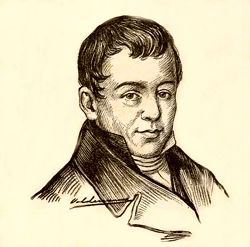 as expendable resources, which, of course, they were in the Cuban sugar industry, from the time of Francisco Arango y Parreño and onward. Sugar itself can be a highly charged food symbol, representative in many cases of a special treat or indulgence. Moreover, conceptions of power are inextricably linked with the history of sugar, both in production and consumption. Because it was a rare and expensive substance "the ability to display and consume sugar was one of the ways of defining power"(Mintz 12). But there is another way in which sugar is implicit in Alea's film, again recalling hints of nationalist imaginings. Schroeder asserts that The Last Supper is a reaction to the Cuban sugar harvest of 1970, "which was to be the basis for Cuba's great leap forward into the developed world"(90). Furthermore, he writes, "The parallelisms with Cuba's first sugar boom in 1792 cannot have escaped Alea, especially since the effect of the 1970 harvest on Cuban Marxism was similar to the effect of the 1792 harvest on Cuban Christianity: In each case, a potentially liberating message degenerated into stultifying dogma"(91-92). Hernández proposes a reading of the Count as a Castro figure who has perhaps bought into "the religion of revolution" a bit too much (844), and Alea confirms the idea to a certain extent. He says, "En todas partes hay gente que asume el comunismo como una religión. Creo que es funesto, porque así empiezan a distorsionar su sentido. Quizás La última cenacontribuya a hacerlo entender" (qtd. in Evora 44). In other words, this distortion is the meta-representation of Sebastian's cautionary tale of a two-headed truth.
as expendable resources, which, of course, they were in the Cuban sugar industry, from the time of Francisco Arango y Parreño and onward. Sugar itself can be a highly charged food symbol, representative in many cases of a special treat or indulgence. Moreover, conceptions of power are inextricably linked with the history of sugar, both in production and consumption. Because it was a rare and expensive substance "the ability to display and consume sugar was one of the ways of defining power"(Mintz 12). But there is another way in which sugar is implicit in Alea's film, again recalling hints of nationalist imaginings. Schroeder asserts that The Last Supper is a reaction to the Cuban sugar harvest of 1970, "which was to be the basis for Cuba's great leap forward into the developed world"(90). Furthermore, he writes, "The parallelisms with Cuba's first sugar boom in 1792 cannot have escaped Alea, especially since the effect of the 1970 harvest on Cuban Marxism was similar to the effect of the 1792 harvest on Cuban Christianity: In each case, a potentially liberating message degenerated into stultifying dogma"(91-92). Hernández proposes a reading of the Count as a Castro figure who has perhaps bought into "the religion of revolution" a bit too much (844), and Alea confirms the idea to a certain extent. He says, "En todas partes hay gente que asume el comunismo como una religión. Creo que es funesto, porque así empiezan a distorsionar su sentido. Quizás La última cenacontribuya a hacerlo entender" (qtd. in Evora 44). In other words, this distortion is the meta-representation of Sebastian's cautionary tale of a two-headed truth.
A religious devotion to communism notwithstanding, it is sure that one facet of the film that would resonate with a Cuban audience is the recognition of hunger and the importance of food. Social and economic inequality meant that, prior to the Revolution, the majority of Cubans suffered from poverty and malnutrition. In the 1950's sociologist Lowry Nelson documented the existence of the rural poor in Cuba, many of them children suffering from starvation and infection from parasitic worms. The main dish of the poor was something called "rooster soup," a mixture of water and brown sugar (Benjamin et. al. 3). Rectifying the disparity became the focal point of the movement, an idea articulated by Che Guevara in 1960: "Our duty is, I repeat, first of all, before anything else, to see to it that no one in Cuba goes without food" (qtd. in Benjamin et. al. 15). The solution was food rationing, and the libretas were well established by 1976, though not without some controversy. As Mona Rosendahl has noted, rationed allotments are not always sufficient to last the month, nor are they necessarily decent quality goods. She says, "Although the Cuban economy provides most citizens with a comfortable standard of living, there is also a considerable bureaucracy. The lack of goods is something that Cubans struggle with every day"(29). And indeed, food, its procurement, abundance, or lack thereof, has become an ingrained part of Cuban daily life. Medea Benjamin, Joseph Collins, and Michael Scott, authors of No Free Lunch: Food and Revolution in Cuba Today,write, “Unlike rationed foods, the availability of which has been reliable for years, many nonrationed foods come and go [...]. So keeping abreast of what is available, and where, has turned into something of a national pastime"(44).
Thus, Alea's cinematographic window highlights dual facets of the revolutionary project: the redistribution of material goods, namely nutritional ones, and the recuperation of the black contribution to Cuban history. Steve Zimmerman and Ken Weiss, authors of Food in the Movies, acknowledge the prominence of food in The Last Supper, but declare that its use "defies categorization"(196). I disagree. Alea's interpretation of the Bayona incident is significant beyond the obvious condemnation of oppressive religion, for it lies at the interstice between appetite and need, which, in this film at least, are competing interests. Part of the Marxist credo is the assertion that you cannot consume ideology on an empty stomach, and therein lies the Count's fatal error; in the simultaneous proffering of dinner and dogma they become confused. Though many foodstuffs such as sugar, salt, and certain meats and fruits have historically been endowed with conceptions of power or privilege, hunger is ignorant of socioeconomic status. Hunger is understood universally, regardless of dietary restrictions or affectations of taste, and the basic animal need for food will always transcend rhetoric, thus giving those who can bestow or withhold food remarkable power. For the Afro-Cuban ancestry this was understood inherently, and led to the creation of their own nutritional resources, thereby subverting the superstructure. Hence, by creating a Marxist film that has this segment of the population as its focal point, Alea is positing a nationalistic version of commensality that is truly inclusive, but also one that is self-reflexive. The emphasis on the rich history of Afro-Cubans, for so long the nameless, faceless other, is another step in what Alea terms “La reivindicación de Calibán”(15), bringing what was once one of the least valorized segments of the population to the forefront of national consciousness, and according them a place at the table.
Weiss, authors of Food in the Movies, acknowledge the prominence of food in The Last Supper, but declare that its use "defies categorization"(196). I disagree. Alea's interpretation of the Bayona incident is significant beyond the obvious condemnation of oppressive religion, for it lies at the interstice between appetite and need, which, in this film at least, are competing interests. Part of the Marxist credo is the assertion that you cannot consume ideology on an empty stomach, and therein lies the Count's fatal error; in the simultaneous proffering of dinner and dogma they become confused. Though many foodstuffs such as sugar, salt, and certain meats and fruits have historically been endowed with conceptions of power or privilege, hunger is ignorant of socioeconomic status. Hunger is understood universally, regardless of dietary restrictions or affectations of taste, and the basic animal need for food will always transcend rhetoric, thus giving those who can bestow or withhold food remarkable power. For the Afro-Cuban ancestry this was understood inherently, and led to the creation of their own nutritional resources, thereby subverting the superstructure. Hence, by creating a Marxist film that has this segment of the population as its focal point, Alea is positing a nationalistic version of commensality that is truly inclusive, but also one that is self-reflexive. The emphasis on the rich history of Afro-Cubans, for so long the nameless, faceless other, is another step in what Alea terms “La reivindicación de Calibán”(15), bringing what was once one of the least valorized segments of the population to the forefront of national consciousness, and according them a place at the table.
Notes
1. Jameson claims that Latin America as a whole and Cuba in particular are special cases because of multiple histories of conquest and colonization and greater vulnerability to hegemonic aggression, presumably from the capitalist United States. In Cuba, he argues, the social consciousness of the 19th century battle for independence informs the Revolutionary consciousness of 1959, which would seem to iterate my position that the film uses the colonial sugar industry with intent.
2. This is delivered in Creole Spanish that is wonderfully musical though clearly not grammatical. The approximate English translation is as follows: “In Africa, when black man hungry for many days, he not hungry just one day, he hungry many days and his whole family hungry. Once upon a time a good father did not have no food to bring to family. He called his best son, the one he loved most, and said, 'My son, tomorrow we go get food.' . . . He walked and cried, walked and walked, cried. . . . When they were about to reach the beach the son asked the father, 'Father, why you crying and crying while you walking?' 'Oh my son! Your father crying because father has to sell son to get food for house. And walk and walk, and when they get to the beach where blacks and whites do their business, the son speak first and sell the father right then and there. Then he bought food for the family!
But the story's not finished yet! When the family, hmm! saw the son and not the father, they asked, 'Son, where your father?' 'He's the food.' And for selling his father, the family took him to the authorities and they put him on trial. And you know what was the punishment? They sold him to a white man! Ay! And with the money, the family ate twice!” (emphasis mine)
Works Cited
Ahmad, Aijaz. “Jameson’s Rhetoric of Otherness and the ‘National Allegory.’” Social Text 17 (Autumn, 1987): 3-25.
Alea, Tomás Gutiérrez. “El Verdadero rostro de Calibán.” Cine Cubano. 126 (1989): 12-22.
Andrews, George Reid. Afro-Latin America: 1800-2000. Oxford: Oxford UP, 2004.
Barthes, Roland. "Toward a Psychosociology of Contemporary Food Consumption." Food and Culture. Ed. Carole Counihan and Penny Van Esterik. New York: Routledge, 1997. 20-27.
Benjamin, Medea, Joseph Collins, and Michael Scott. No Free Lunch: Food and Revolution in Cuba Today. San Francisco: Institute for Food and Development Policy, 1984.
Captain-Hidalgo, Yvonne. "The Poetics of the Quotidian in the Works of Nancy Morejón." Callaloo 33 (Autumn 1987): 596-604.
Douglas, Mary. "Deciphering a Meal." Food and Culture. 36-53.
Evora, José Antonio. Tomás Gutiérrez Alea. Madrid: Cátedra/Filmoteca Española, 1996.
Ferry, Jane F. Food in Film: A Culinary Performance of Communication. New York: Routledge, 2003.
Hernández, Juan Antonio. “Multitud, Devenires, y éxodo: La última cena de Tomás Gutiérrez Alea.” Revista Iberoamericana. 69 (2003): 839-848.
Hegel, G. W. F. Phenomenology of Spirit. Trans. A.V. Miller. Oxford: Oxford UP, 1977.
Jaehne, Karen. Rev. of The Last Supper, dir. Tomás Gutiérrez Alea. Film Quarterly 33.1 (1979): 48-53.
Jameson, Frederic. “Third World Literature in the Era of Multinational Capitalism.” Social Text 15 (Autumn, 1986): 65-88.
Korsmeyer, Carolyn. Making Sense of Taste: Food and Philosophy. Ithaca: Cornell UP, 1999.
Last Supper, The. Dir. Tomás Gutiérrez Alea. La Habana: Instituto Cubano de Arte y de Industria, Center for Cuban Studies, 1976.
Manzano, Juan Francisco. The Autobiography of a Slave. Trans. Evelyn Picon Garfield. Detroit: Wayne State P, 1996.
Mead, Margaret. “The Changing Significance of Food.” Food and Culture. 11-19.
Mintz, Sidney W. Tasting Food, Tasting Freedom: Excursions into Eating, Culture, and the Past. Boston: Beacon, 1996.
Montejo, Esteban. The Autobiography of a Runaway Slave. Trans. Jocasta Innes. Ed. Miguel Barnet. New York: Vintage, 1973.
Rosendahl, Mona. Inside the Revolution: Everyday Life in Socialist Cuba. Ithaca: Cornell UP, 1997.
Schroeder, Paul A. Tomás Gutiérrez Alea: The Dialectics of a Filmmaker. New York: Rutledge, 2002.
Warnes, Andrew. Hunger Overcome? Food and Resistance in Twentieth-Century African American Literature. Athens: U of Georgia P, 2004.
Zimmerman, Steve and Ken Weiss. Food in the Movies. Jefferson, NC: McFarland, 2005.


